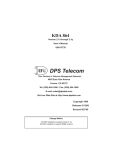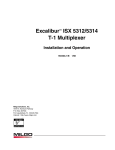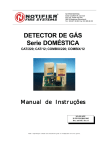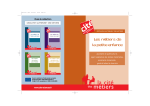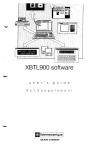Download 10/ 30\ RULE
Transcript
United States Patent [19] [11] Patent Number: [45] Date of Patent: Vrenjak 5,063,523 Nov. 5, 1991 [54] NETWORK MANAGEMENT SYSTEM WITH EVENT RULE HANDLING FOREIGN PATENT DOCUMENTS 0201308 11/1986 European Pat. Off. . [75] Inventor: Milan J. Vrenjak, Coral Springs, Fla. [73] Assignee: Racal Data Communications Inc., Sunrise, Fla. OTHER PUBLICATIONS (Plzgssggle, K., Expert Systems for Experts, pp. 138-140 [21] Appl. No.: 438,375 [22] Filed: 0260579 3/1988 European Pat. Off. . “Understanding UNIX A Conceptual Guide”, Groff & Weinberg, pp. 68-97 (1983). RacaL-Milgo’s CMS 2000 Network Management Sys Nov. 16, 1989 term. [51] Int. Cl.5 ..................... .. G06F 15/16- G06F 13/42 ‘ , _ [52] U.S. c1. ................................... .. 364/514; 395/200 PM”? hammer-[mph L- Dlxo", [58] A’mmey' 1489'“ 0" F"'"—Je"Y A- Mme’ Field of Search ...................... .. 364/514, 200, 900 56 [ ] R C d eferences “e [57] ABSTRACT A data communication network management system 115- PATENT DOCUMENTS 4,385,384 allows a user to establish rules which are pattern 5/1983 Rosbury et a1. ................. .. 311/206 matched to attributes Of incoming events, Such =15 4,545,011 10/1935 Lyon a a1_ 364/200 alarms, from network objects. When a match is found, 4,660,141 4/1987 Ceccon et al. 364/200 the network management system retrieves a user pre 4,733,351 3/1988 364/200 pared command SCRIPT ?le and substitutes attributes 9/1989 Blakely-Fogel et a1. ......... .. 364/513 mand SCRIPT IS the“ Invoked F0 allow the user to , Eat“: ---- , 4,864,492 Peirent . - - - - - - - - - ~ - - stra ~ - 1- - 4 - - ~ - - a et a . from the event into the command SCRIPT. The com - - - - - - .................... .. ' ‘ 4912 656 3/1990 c .n eta] 364/514 4’951’192 8/1990 cram Jr'e'g'g'l"""""""""" " 364/200 program the system to automatically take predeter mined actions upon the occurrence of network gener 4I974I131 9/1990 Sinder’son ...... @111: 11:: 364/550 ated events speci?ed by the “Ser 4,975,83l 12/1990 Nilsson et a1. . . ... . . . . . . . .. 364/200 4,975,838 12/1990 Mizuno et a1. .................... .. 364/900 3B\ SCRIPT \ EDITOR \ MHNHGER \ EDITOR 34\ /14 _ MonEM EVENT 32\ 13 16 Claims, 3 Drawing Sheets __ / 16 _ MODEM _ RULE ' MODEM /18 DHTH PRINTER "' COMMUNICHTIONS NETWORK /20 I€-——-———>__‘ MODEM _ MHNRGEMENT (.é TERMINHI- SYSTEM MODEM /22 3e\ SCHEDULING ‘ \ 12 PROCESS . 4o\ \ 10/ 30\ \ 11\ \ EVENT TFiBLE 24 RULE TRBLE DFITHBFISE ; MFINFIGER 0 25 US. Patent :u Eco: 7.1 9 m. 5, 1991 2 5 0: zwmoz om sheet 1 of 3 5,063,523 mm mm. Eco: .! Eco: l mm E , .C .FZmu 1/0.5m E P E G U431 1/0.5m x. wZOHPEUD mOZk Zmb>w UZHJDQImZm UOwE wm h? M3 1 m/j wt. E/UO ZE US. Patent Nov. 5, 1991 Sheet 3 0f 3 5,063,523 FIG.3 204. EVENT RECEIVED PRTTERN MHTCH EVENT TO RULES IN RULE TFIBLE 215\ RETRIEVE SCRIPT NFIME 220\ MRP PRRF-TMETERS FROM EVENT TO SCRIPT 22"'\ INVOKE SCRIPT WITH PHRFIMETERS 226 l SEND RESULT TO USER ' 1 5,063,523 2 bute and the rule match. A predetermined SCRIPT containing at least one command upon determination in the comparing means that the attribute matches the rule is then invoked and executed. NETWORK MANAGEMENT SYSTEM WITH EVENT RULE HANDLING BACKGROUND 1. Field of the Invention This invention relates generally to the ?eld of net work management systems for data communications networks. More particularly, this invention relates to a In another embodiment of a computer based data communication network management system according to the present invention, a method for establishing and using a rule to react to network events, includes the steps of: method and apparatus for allowing a user to de?ne a user de?ning a criterion associated with a network functions or SCRIPTed operations to be performed event upon occurrence of which an action will be taken; a user de?ning a SCRIPT of commands to be invoked upon occurrence of events meeting the criterion; receiving an event message from the network; in the computer based data communication network manage ment system, comparing attributes of the event with the user de?ned criterion; and if the attributes match the user de?ned criteria, invok upon receiving a network event and satisfying a set of criteria in the form of a rule. 2. Backqround of the Invention Commercially available data communications net work management systems have been used for a number of years to enable an operator to manage a large group of objects within a data network. Such objects include modems, multiplexers, i restoral devices, Digital Ser vice Units (DSU’s), encryption devices, packet ing the SCRIPT of commands. switches, etc. An example of such a system is shown in US. Pat. No. 4,385,384 to Rosbury et al which is hereby set forth with particularity in the appended claims. The invention itself, however, both as to organization and method of operation, together with further objects and advantages thereof, may be best understood by refer ence to the following description taken in conjunction The features of the invention believed to be novel are incorporated by reference. Such network management systems typically allow a user to de?ne certain informa tion about the network in an integral database which is used in the network management function. It is typical with the accompanying drawing. for such databases to keep track of information such as location of the object, type of object, object id, and interconnection information relating to the object (i.e., BRIEF DESCRIPTION OF THE DRAWING FIG. 1 shows a high level block diagram of a net what other objects are connected to the object in ques work management system. tion). FIG. 2 shows a flow chart of the rule de?nition mode of the present invention. The commercially available CMS ZOOOTM network management system produced by Racal-Milgo, Fort FIG. 3 shows a flow chart of the event rule handling Lauderdale, Fla., operates on “alarms” received from objects in the network indicating that certain events or 35 system operation. problems have taken place. It is desirable for the user of DETAILED DESCRIPTION OF THE such a system to be able to automate responses to such INVENTION alarms in a manner which might not be contemplated by Turning now to the drawing in which like reference the designer of the network management system. The present invention provides such a mechanism by allow 40 numerals designate corresponding parts or functions throughout the several ?gures thereof, and in particular ing the user to establish rules with which the alarm to FIG. 1 thereof, there is shown a network manage events are compared. Upon satisfaction of such rules, ment system 10 having an integral database manage prede?ned SCRIPTs of commands can then be exe ment system 11 such as the ORACLE TM relational cuted to invoke predetermined processes. SUMMARY OF THE INVENTION ' It is an object of the present invention to provide an 45 database management system produced by Oracle Corp. A user terminal 12 is attached to the system in a known manner to provide for a user interface to the system. A printer 13 may also be attached to the system to provide a log of activities. The network management ties for applying user de?ned rules to network events such as alarm events received from network objects 50 system 10 may be based upon a minicomputer, mi crocomputer, workstation or other suitable host as is It is an advantage of the invention that any user de conventional and includes an operating system such as ?ned rules can be established, the satisfaction of which UNIX TM as well as RAM memory and disk storage automatically causes execution of a command SCRIPT. improved network management system having capabili These and other objects and advantages of the inven (not shown explicitly). In the preferred implementation, tion will become apparent to those skilled in the art 55 a DECstation 3100TM RISC workstation manufac upon consideration of the following description of the invention. In one embodiment of the present invention, a com puter based data communication network management system for allowing a user to define actions to be taken in the event of occurrence of a predetermined event within a data communication network includes a net work interface receiving event messages from a net work object situated in the data communication net tured by Digital Equipment Corp. is used. The network management system 10 is connected either directly or indirectly through communications channels to various network objects as previously de scribed. This connection can be viewed conceptually for purposes of this disclosure as direct connections as shown. The objects shown in FIG. 1 correspond to a small set of network objects coupled to the network and include modems 14, 16, 18, 20 and 22; and multiplexers work, the event me'ssage containing an attribute. A rule 65 24, 26 and 28. These objects are interconnected, in gen table stores a user de?ned rule within the network man era] with many other objects, in a data communication agement system. The attribute is compared with the network which are not shown for simplicity. A large rule upon receipt of the event to determine if the attri portion of the Network Management System 10 is de 3 5,063,523 voted to data receipt and acquisition using known inter 4 Event Table 40. The allowable‘ Event Classes and Codes are made available through the system documen facing techniques such as those- described in more detail in the Rosbury et al. patent. tation such as a user manual or release notes. An alterna The present invention also includes a Rule Table 30 tive could visually display the Event Table 40 to the forming part of database 11 which stores a plurality of 5 user by entering an appropriate command (e.g. a soft rules created by the user as will be described herein. function key or the like). The Network Management System 10 also includes a For purposes of this document, an “event rule” de Rule Editor 32 which is used to permit the user to cre ?nes the selection criteria for a given incoming event ate a rule and an Event Manager 34 which receives and and an action that is to be performed when a match is made. A match is ‘made when the values of the attri butes making up the event matches the selection criteria manages incoming alarms and other events from the various network objects such as 14-28. A SCRIPT Editor 36 is used to create various SCRIPT ?les to be executed as will be described. SCRIPT editor 36 is simply a text editor. A Scheduling process 38 schedules given. Matches may be determined using pattern match ing techniques similar to those used by word processors for search and replace functions in the preferred em the various SCRIPTed operations invoked upon satis 15 bodiment. Selection criteria are applied individually faction of a rule. An Event Table 40 provides a list of valid event codes and is available to the user in the form of a hard copy or may be made available from the termi nal 12.‘ The user of the network management system 10 may communicate via terminal 12 with the various modems, over each incoming event, i.e., no integration of events is done in the preferred embodiment. An incoming event message may match many event rules resulting in many actions to be taken. Such actions are scheduled to be performed by the scheduling process 38. A rule is made up of a set of criteria de?ned by the multiplexers and in general other network objects user. Each criterion can select for a speci?c value or . (sometimes referred to herein as units) in order to obtain range of values for a single event attribute. Event attri status or functional information, to attempt to locate butes can be grouped into two classes: those that are malfunctions, to switch in redundant equipment and in 25 common to all events, and those that are speci?c to an general monitor the state of the network. In the pre individual event type. The class of common event attri ferred embodiment, the network objects communicate butes of the preferred embodiments consists of the fol lowing event attributes: Event Class, Event Code, with the network management system 10 via an out of band secondary channel, but this is not to be limiting. Date, Time, Object id, and Object Type. Similarly, in the preferred embodiment, network or 30 Event speci?c attributes are those attributes that fur network object malfunctions are frequently reported to ther describe a particular event. An example of a spe the network management system 10 via alarm events ci?c event attribute would be the alarm status, such as (messages) having a plurality of attributes which are detected or canceled. The speci?cation of multiple cri transmitted via the secondary channel to the network teria, collectively de?ne a rule that can select for an management system 10. In general, asynchronous 35 event or range of events that can initiate some action. alarms as well as polled responses may be considered events in the present system. In other systems, in-band or out-of-band secondary channels may used and alarm The present invention allows the user to specify se may be readily adapted to use the present invention by nected together by the logical operator AND or OR in those skilled in the art. the present embodiment. In other embodiments, more lection criteria from a subset of the class of event attri butes. This subset includes the main selection criteria type information may be conveyed by answering polls —Event Class and Event Code, and the additional se or by using other protocols. Such equivalent schemes 40 lection criteria-any three other event attributes con The Event Rule Handling feature of the present in or less than three other event attributes may be permit vention provides the user with the capability to manage ted. rules that will be used by the Event Manager 34 to 45 In addition to de?ning the criteria for selecting an selectively initiate some action. For purposes of this event, the user must associate an action to be performed document, an event is de?ned as a change of state of an when the rule is satis?ed. The action performed will be ’ object(s) caused by some activity performed or detected by the network management system 10 at a given in stant of time. An event is characterized by the follow the initiation of a prede?ned command ?le (SCRIPT) for additional processing. The term Command LIST or mg: command ?les instead of the UNIX term SCRIPT. In An Event Class and Code, where the Event Class de?nes a common category of events and the Event Code de?nes a speci?c instance of an event within a class. Objects associated with the event including the ob ject name and its type. There may be single or multiple objects that may be involved in the event such as modems, multiplexers, etc. or abstractions of such ob jects such as sites (all such objects at the site) or domains (all objects in a particular domain). CLIST (IBM’I‘M terminology) is sometimes used for either case, the ?le is simply a string of commands which can be executed on the network management system 10, similar to a DOS Batch ?le, which is exe 55 cuted when the rule is satis?ed. A SCRIPT ?le may contain a number of prede?ned features speci?cally suited to managing an event and the user’s network. Therefore, a sophisticated user can automate many of the activities that are performed to evaluate an event, eliminating much of the routine manual effort normally associated with these activities. Time the event was detected. The task of monitoring events, applying the rules, and initiating the SCRIPT ?les, is performed by the Event such as, status, alarm levels and so on. Manager 34. In the preferred embodiment, the types of The event attributes are formatted into text for the 65 function associated with rules fall into 4 generic classes; Additional data further characterizing the event, user by the Event Manager 34. A list of valid events and their descriptions is maintained as part of the con?gura tion of the network management system within the de?nition of a new rule, display of an existing rule(s), modi?cation of an existing rule, and deletion of an exist ing rule. 5 5,063,523 There are two operational modes associated with the present invention: rule de?nition and operation. In the rule de?nition mode, as described in connection with FIG. 2, while the system operation mode is described in 6 Event Class can be speci?ed‘ in the preferred embodi— ment. This is presented to the user with an implicit equals sign (=) to indicate only one Event Class can be selected. The operand entered should correspond 'to a connection with FIG. 3. 5 valid event within the Event Table 40. Turning now to FIG. 2, the rule de?nition mode is For example, the user could de?ne a rule for a spe described. The process begins at 100 where a user com ci?c Event Class in the following manner: mand is awaited. When a command is received, a case function is performed at 102. The rule de?nition fea tures can be invoked by using the following commands: EVENT CLASS: =0600 ADD RUL, MOD RUL, DEL RUL, DIS RUL and EVE RUL. EVE RUL is a general entry point to the In this example, the user has speci?ed that the rule applies to only those events that have an Event Class of other 4 speci?c features (e.g. a command executed from a higher level menu) and is not shown in the drawing for simplicity. Those skilled in the art will appreciate that further speci?c editing commands can also be im 0600. The particular codes that are used to relate to an - plemented such as a copy rule command which would copy an existing rule so that it can be modi?ed to create event class are, of course, system dependent and not to be limiting. in this case an Event Class of 0600 might represent network alarm events. The Event Code name is followed by an operator ?eld in the same fashion as the Event Class input exam a new rule. ple. This ?eld permits entry of a two digit relational The Add Rule function 104 provides the user with the ability to de?ne new rules and associate them with operator which can be one of the following; an equals a speci?c action. In order to de?ne a new rule, the user is required to provide a rule identi?er at 108 which must be unique among the rules created by that user. The user chooses the Add Rule function 104 by entering ADD RUL on the command line. The rule identi?er (rule id) serves as a key to the rule and aids the user in managing the rules that he or she has de?ned. At 108 the user is prompted to supply a rule name (rule id) to be created. The ?rst step to de?ning a rule will be the speci?cation of a rule id at 108. The rule id can be any combination of, for example, twelve alphanumeric sign (=), a not equals operator (!=), a greater than (>), a less than (>), a greater than or equal to (> =), or a less than or equal to (< =). Following the ‘speci?cation of the operator, the next ?eld will specify the operand. The operand ?eld is used to specify a target value for selection. Example: EVENT CODE: = 0004 In the example, the user has speci?ed that the rule ap plies to only those events that have an Event Code of 0004 which might represent, for example, a received characters and must be unique among the rules de?ned line fault (RLF) alarm (assuming event class 600). by this user. The second operator ?eld is optional and is provided After de?ning the rule criteria at 110, the user can 35 for the user to specify a range of values for the criteria. associate an action with the rule. This is done by supply This ?eld will accept one of two possible entries; either ing the name of a SCRIPT at 114 that is to be executed whenever an event meets the previously de?ned crite ria. In addition to specifying the SCRIPT name, the user is asked to specify what event parameters are to be passed to the SCRIPT, and the order in which they are to be passed to the SCRIPT at 114. When the user has an AND, or an OR. The remaining two ?elds are pro vided for the de?nition of a second operator and 0perand. For example, the user could de?ne a rules for a range of event codes in the following manner. Example: completed entry of the rule in steps 108, 110 and 114, the rule table 30 is updated at 118 and the proces s EVENT CODE: > :0004 AND < =0035 returns to await another command. 45 As described above, the process of adding a new rule In This example, the user has speci?ed that the rule is broken up into two distinct parts; the rule criteria applies to only those events that have an Event Code de?nition, and speci?cation of the SCRIPT and associ between 0004 and 0035 inclusive. ated parameters. A criteria de?nition screen is displayed The user can specify additional selection criteria ?rst. The Add Rule function then allows the user to based on the event attributes of the logged messages specify the criteria that will make up the, new rule at 110. Following the entry of a rule id, the de?nition of a new rule will continue with the speci?cation of the main selection criteria —Event Class plus a logical selected by the main selection criteria of Event Class and Event Code. The user can also express the relation ship between the event attributes by using the AND, expression de?ning speci?c Event Codes for the Event 55 OR logical operators. Only a maximum of, for example, three event attributes might be permitted in some em Class. By de?ning multiple criteria for a rule, the user can make the rule have a very narrow focus in order to select for a very speci?c event. Alternatively, by speci fying wide value ranges, the rule can be made to apply to wide range of different events. In order to further understand how a rule is created in the preferred implementation, it may be helpful to study the details of criterion input for the preferred implemen tation. In other implementations, more ?exible expres 65 sion of criteria may be devised. In the preferred embodi ment, the user is prompted of the Event Class that de ?nes the category of events to select from. Only one bodiments The allowable event attribute types to specify addi tional selection criteria are based on the common attri butes of all events that may match based on the main selection criteria. For example, class 600 and codes 3-6 might refer to the events listed in the following TABLE 1: TABLE 1 EVENT CODE DESCRIPTION 003 STR - STRcaming primary channel 004 O05 RLF - Received Line Fault MPF - Modem Power Fail 5,063,523 7 EVENT CODE 006 8 Once all the rule attributes are de?ned, the rules are i TABLE l-continued" saved by the system in rule table 30. A rule can be de?ned without being activated. This DESCRIPTION DNR - Dedicated line Not Restored will allow the user to maintain a library of rules that can be enabled and disabled at will. The systemwill keep These events have the common attributes TIME, UNIT, COMPONENT, SITE, DOMAIN and STA TUS. The common attributes for the main selection criteria are displayed when specifying the additional selection criteria. Entry of the additional selection criteria de?nition is track of the date and times a rule was created, last modi ?ed, and enabled/disabled in the preferred implementa tion. Enabled rules will be reactivated after the network management system has been stopped and restarted. The following example shows the de?nition of an event rule’s selection criteria and action in a realistic then prompted. The user can use the relational operator setting, In this example, portions of the screen displays (=, !=, IN) while the logical operators are restricted to (AND, OR). If the “IN” relational operator is used, the suggested value to be used in conjunction with it should are illustrated. be SET 11 where n can take values from 0 to 9. The system, on seeing an IN operator being used, would prompt for the de?nition of the appropriate SET. Those skilled in the art will appreciate that more advanced First in this example, the main selection criteria is de?ned to select all alarm events (class 600) that have code 003 (received line faults). This class and code are known to the user through the Event Table 40 which the user can view for reference by hard copy or by pressing an appropriate soft function key. MAIN SELECTION CRITERIA class <,= EVENT CLASS : 600 EVENT CODE: embodiments can be devised to expand on this aspect. A set is made up of a number of valid objects within = 003 The following additional selection criteria is applied. The alarm event must have a status of ‘detected’ and the object type associated with the set. The types can be must be within a speci?c site-‘MIAMI’ and a domain restricted to the class of event attributes. A system limit 30 ‘BEACH’. Note that the common event attributes for of, for example, 28 members in a set can be imposed. Once all the selection criteria have been de?ned and validated, the user is given the opportunity to associate a SCRIPT with the rule. This is done by prompting the user for the name of the SCRIPT that is to be executed 35 upon successful acquisition of an event that meets the the above main selection criteria are shown with the prompt. ADDITIONAL SELECTION CRITERIA Value,SETn AND,OR currently de?ned rule. No checking will be performed to insure that the speci?ed SCRIPT actually exists until STATUS SITE = = detected MIAMI AND AND the rule is enabled in the preferred embodiment. This DOMAIN = BEACH allows the user to de?ne a rule before creating a SCRIPT. ' The next step is the speci?cation of the arguments and the order in which they are passed to the SCRIPT. Entry of the arguments takes place through the ARGU type = ,l = ,IN ' Common Event Attributes: UNIT SITE DOMAIN STATUS UNIT__TYPE The following SCRIPT association speci?es a SCRIPT to carry out an intended restoral action on the MENTS: prompt. Each of the arguments should be 45 unit speci?ed within the alarm event. Note that the separated by a space and entered in the order in which available event attributes to pass to the script are shown vthey are to be passed to the SCRIPT in the preferred and that only the unit needs to be passed to perform the implementation. A list of the common event attributes is intended operation. listed below the prompt to assist in the entry of the arguments. After completing the entry of the argument 50 list the system will parse the information and display the argument count. The next step allows the user to enable or disable the rule. When a rule is enabled that means the Event Man ASSOCIATED SCRIPT SPECIFICATION SCRIPT NAME: dial_backup- ARGUMENTS UNIT Available Event Attributes: UNIT SITE DOMAIN STATUS ager will read that rule from the rule table and code it 55 The script dial_backup could contain the following line and use that rule to match against incoming events. to put the unit detected by the event into dial backup When it is disabled the Event Manager deletes it from and thus restore communication to the network. The its memory and will not match against it. The default variable $1 will be substituted with the unit detected by condition will be rule disabled. If the user saves the rule the event. in a disabled condition, it will be stored in the database but no event rule matching will be done. If the user DIAL BACKUP UNIT=$l Finally, the user can enable or disable the event by selects to enable a rule the following criteria must be putting the cursor over ‘YES’ or ‘NO’ as shown below. met before allowing it to be enabled. 1. The SCRIPT must be de?ned 2. The SCRIPT association must be Valid. No errors 65 in arguments. 3. Any sets de?ned cannot be empty. 4. The selection criteria must have a valid pattern. RULE ACTIVITY STATUS ENABLE RULE: NO [YES] 5,063,523 The Modify Rule function 124 allows the user to 10 modify existing rules. The rules that can be modi?ed The user can elect to change any or all of the rule criteria and may also change the associated SCRIPT ' may be limited to those that are de?ned by that user in the preferred embodiment. The user can select a partic name and its associated arguments using the SCRIPT ular rule for potential modi?cation by entering its asso ciated rule id at step 128. Upon entry of the rule id, the 5 editor 36. The user may also rename the rule. None of the changes made by the user are effective until the user saves the changes. If the user elects to update the rule user can view the rule that is being modi?ed. In the the system keeps track of the date and time of the modi ?cation. of the rule such as the date and time the rule was cre It is important to note that the Modify Rule function ated, last modi?ed, etc. will not be displayed since they 10 provides the sole means of enabling and disabling rules cannot be modi?ed by the user. once they have been added in the present embodiment, The rule modi?cation process proceeds to step 130 but this is not to be limiting. When it is desired to effect preferred embodiment, the system maintained attributes where the user selects a soft programmed function key a change of the enabled/disabled state of a rule the user representing the modi?cation process he wishes to use. updates the enabled/disabled attribute of the rule to If the user wishes to modify the name of the rule, he 15 ‘enabled’ for the rule change to become effective. selects soft key 132 after which the system prompts him In the preferred implementation, the user has the for a new rule name at 134. The user may then exit at capability to disable and enable event rules on a sched 135 and the process returns at 136. If the user does not uled basis. This is accomplished with the scheduling wish to exit modify rule, control returns to 130. process 38. For example,, the user may wish to turn off If the user elects to change the rule criteria by select 20 a rule during off hours and on when the system is man ing 137, he is prompted for the new criteria at 138 and aged. Or, for another example, it may be desirable to then control passes to 135. If the user selects to modify turn off a rule which requires substantial computing the SCRIPT at 139, he is allowed to change the power during peak hours of system activity. This could SCRIPT name at 140. If he wishes to edit the SCRIPT be accomplished by modifying a rule using the modify at 141, control passes to the SCRIPT editor at 142 after 25 rule process with the following arguments: which the user can exit at 135 if desired. The user may also elect to change the rule status (enabled or disabled) at 144. If so elected, the system prompts for a change at 146 and then control passes to 135. In the preferred MOD RUL RULE_ID= xyz_.rule ENABLE= NO embodiment, an escape key or the like can be used at 30 which will turn off the rule at some time speci?ed in the scheduling feature. any point to move the user back to a higher level opera~ tion at any time in a known manner. Each change is The Delete Rule function 148 allows the user to de individually made to the database when the user enters lete existing rules. For security reasons, the rules that the change. can be deleted are preferably be limited to those that are In operation, the user chooses the Modify function by 35 de?ned by that user. The user can select a particular entering MOD RUL on the command line. For security rules for potential deletion by entering its associated reasons, it is preferred that the system only permit a user to modify rules created by that user. Other methods of rule id at 152. In alternative embodiments, the user may select the rule name from a list by using a pointing invoking the function such as pointing to a menu selec device such as a mouse or the like. The rule selected for tion using a pointing device such as a mouse may also be 40 deletion can be viewed at 152 before the deletion is used in alternative embodiments. In order to modify a con?rmed by the user and carried out by the system. pre-existing rule, the target rule must be ?rst be chosen. When the user elects to delete a speci?c rule, the re This can be done by entering a valid rule id at 128. Only quest is ?rst con?rmed before the actual deletion takes place. This will alleviate the possibility that a user could and system maintained attributes such as creation date, 45 inadvertently delete a rule. After receiving con?rma modi?ed date, and so on, cannot be modi?ed by the tion from the user the rule is then removed from the rule the user de?nable attributes of a rule can be modi?ed user. All the input ?elds will contain the values that are currently de?ned. The user may choose to modify cer tain values and retain others by skipping over them. The rule must ?rst be disabled, in order to modify any of the rule characteristics apart from the rule id. In the pre ferred embodiment, the user can use a soft function key to modify the respective rule attribute. Available soft function keys in the preferred embodiment are “MOD IFY ACT STAT” to enable/disable rule, “MODIFY SCRIPT” to change the associated SCRIPT and its arguments, “MODIFY MAIN SEL” to change the . event class and code criteria, “MODIFY ADD SEL” table at 156 and the process returns at 160. The user chooses the Delete Rule function by enter ing DEL RUL on the command line, or by equivalent means. In order to delete an existing rule, the user enters the rule id of the target rule. Once the rule id is speci ?ed, the user is prompted for con?rmation of deletion. The rule information is also displayed at the same time. If the user con?rms the deletion query, by selecting 55 ‘YES’, the rule will be deleted. If the user chooses ‘NO’ then the previous screen is redisplayed. The con?rma tion prompt will have a default value of ‘NO’ to help prevent accidental deletions. to change the logical expression, “MODIFY RULE The Display Rule function 164 allows the user to display previously de?ned rules. The user can select to ID” to rename the rule and “MODIFY SETS” to alter the contents of the sets. Valid changes are saved as they display a particular rule by entering its associated rule id are made and a status message “CHANGES SAVED at 168. The named rule is then displayed at 174 and the process returns at 178. When displaying a speci?c rule, TO DATABASE" is displayed. the format of the display is analogous to the Modify After the “MODIFY RULE ID" is pressed and the 65 Rule function except that several system maintained rule is renamed, the feature will exit and return to the ?rst screen for MODIFY RULE with the name of the new rule displayed for the rule id prompt. ?elds will be displayed along with the user de?ned data. This function provides for display only, no changes can be made through this function. 11 5,063,523 Alternatively, the user can scroll through the rules, viewing them one at a time by pressing an appropriate 12 E-mail type functions. Control then returns to 204 where the next event is awaited. With reference to the flow charts described above, it will be understood by those skilled in the art that error trapping has not been described so that the invention can be readily understood without undue burden of known error trapping techniques. Those skilled in the soft key (a software de?ned function key) from the console at 172. The scrolling process is then initiated at 182. When scrolling through the rules the operator can select to view all de?ned rules or only rules de?ned by that user. The user chooses the Display Rule function by enter art will understand how to use such error trapping ing DIS RUL on the command line. There are two techniques as required to attempt to assure that only methods of displaying existing rules in the preferred 10 valid entries are made and the like. In most instances of embodiment. In the ?rst method the user can display a rule entry and the like, the user can leave a procedure to get to the next higher level by use of an exit key or speci?c rule by entering it’s rule id. Once the rule id has been entered, the rule will be displayed in formatted ?elds. In the second method of rule display, the user utilizes NEXT PAGE and PREVIOUS PAGE hard keys to page through rules. The rules are displayed in a terse format with only the very basic information displayed. Thus more than one rule can be viewed at the same time. When scrolling through rules the user can select to view all the rules in the rule table or only those he or she has de?ned. When the Display Rule function is ?rst invoked the escape key, the status of which is continually monitored by the system. Other escape mechanisms can be imple mented in alternative embodiments without departing from the present invention. In an advanced embodiment of the present invention, the system designer can utilize the present invention to update internal processes. For example, suppose the user has a window de?ned to display a map of the net work. If modem 14 sends an alarm to the network man agement system 10, the system designer may wish the map to be updated to reflect this alarm (e.g. change user is prompted for the rule id of the rule to be dis color of modem 14 on the map). In this case, a rule can 25 played. Also active are two soft function keys “DIS be established which passes the alarm information to the PLAY USER DEF” and “DISPLAY ALL” which system process which generates the map display. Other allow the user to view all the user de?ned rules or all variations of such rules will occur to those skilled in the art. the rules in the system, in a scrolling form. The current state of the scope of view is displayed at the top of the Thus it is apparent that in accordance with the pres window. ent invention, an improved apparatus and method that When displaying a rule, the ?rst screen presented to fully satis?es the objectives, aims and advantages is set the user displays the rule criteria as well as the system forth above. While the invention has been described in maintained data. The system maintained data includes conjunction with speci?c embodiments, it is evident Creation Date, Date Last Modi?ed, Enabled Date and 35 that many alternatives, variations, modi?cations and User Id. These ?elds will be displayed near the top of a permutations will become apparent to those skilled in window on the screen of terminal 12. the art in light of the foregoing description. Accord~ The SCRIPT association data is also displayed on the ingly, it is intended that the present invention embrace same page/screen. When viewing the criteria display all such alternatives, variations, modi?cations and per screen, the constituents of sets, if any, can be viewed by mutations as fall within the spirit and broad scope of the using a “DISPLAY SETS” soft function key and speci appended claims. fying the set id. The NEXT PAGE and PREVIOUS What is claimed as new is: PAGE hard keys can be used to page through the set 1. A computer based network management system members. for managing a data communication network, said net All four of the above functions can be invoked by 45 work management system having been developed by a entering EVE RUL on the command line in the pre designer to operate in a predetermined normal manner ferred embodiment. This leads to a function key selec for use by a network management system user, compris tion screen whereby the user can select the appropriate ing in combination: feature. In other embodiments, soft keys, drop down receiving means for receiving an event message from menus or windows, or other devices may be used to 50 a network object situated in said data communica access the commands. tion network, said event message reporting an Turning now to FIG. 3, the system operation mode is event within said data communication network and described. The process starts at 200 after which control containing an attribute; passes to 204 where the receipt of an event is monitored. storing means for storing a user de?ned rule within If an event has been received at 204, a pattern match is 55 said network management system said user de?ned performed on the attributes of the received event to rule being a rule added to said network manage compare these attributes with each rule in the rule table ment system by said user to customize said prede 30. If no match is found at 212, control returns to 204. If termined normal manner of operation of said net a match is found, the event manager 34 retrieves the work management system; name of the SCRIPT to be executed at 216. At 220, the comparing means for comparing said attribute with parameters from the event are mapped to the appropri said rule upon receipt of said event message to ate variables in the SCRIPT and the SCRIPT is in determine if said attribute and said rule match; and voked at 224. The results of the SCRIPTed operation invoking means for invoking a predetermined are then sent to the user at 226. In the preferred embodi ment, this is accomplished by writing the results to a ?le 65 and sending the user a message telling him to look at the ?le to obtain the results of the SCRIPTed operation. The message can be in a form similar to conventional SCRIPT containing at least one command upon determination in said comparing means that said attribute matches said rule. 2. The apparatus of claim 1, further comprising means for editing said rule. 13 5,063,523 14 ing attributes of said event message with said user 3. The apparatus of claim 1, wherein-said comparing means includes pattern matching means for determining de?ned criterion; and if said attributes match said user de?ned criterion, invoking said SCRIPT of commands to effect cus if a character pattern in said rule matches a character pattern in said attribute. 4. The apparatus of claim 1, wherein said SCRIPT is tomized operation of said predetermined normal manner of operation of network management sys stored in a SCRIPT ?le. term. 5. The apparatus of claim 4, further comprising means for editing said SCRIPT ?le. 6. The apparatus of claim 1, wherein said storing 9. The method of claim 8, wherein said invoking step comprises determining a name of said SCRIPT and retrieving said SCRIPT. 10. The method of claim 8, further comprising sup means includes means for storing a plurality of user plying information relating to said event message for substitution within said SCRIPT. 11. The method of claim 8, further comprising the means includes means for comparing said attribute with each rule stored in said storing means until either said 15 step of storing said criterion in said computer based data communication network management system. match is found or it is determined that no match exists. 12. The method of claim 8, further cmoprising the 8. A method for establishing and using a rule to react step of storing said SCRIPT of commands in said com de?ned rules. 7. The apparatus of claim 6, wherein said comparing to a network event occurring in a data communication puter based data communication network management network, comprising in combination the steps of: system. 13. The method of claim 8, wherein said comparing step is carried out by determining if a character pattern a network management system user de?ning a crite rion associated with said network event upon oc in said criterion matches a character pattern in said currence of which an action will be taken; event message. a network management system user de?ning a 14. The method of claim 8, further comprising the SCRIPT of commands to be invoked upon occur 25 step of editing said SCRIPT. rence of said event meeting said criterion in order 15. The method of claim 11, wherein said storing step to produce said action; includes storing said criterion in a storing means, and receiving an event message from an object in said wherein said storing means stores a plurality of user network; 30 de?ned criteria. in a computer based data communication network 16. The method of claim 11, wherein said storing step management system, said network management includes storing said SCRIPT of commands in a storing system having been developed by a designer to means, and wherein said storing means stores a plurality operate in a predetermined normal manner for use of said SCRIPTS of commands. t 1 t t i by said network management system user, compar 35 45 50 55 65











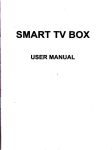


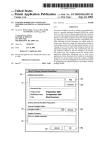
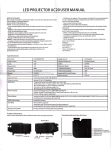
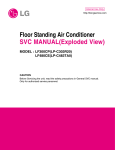
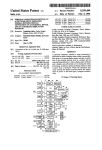

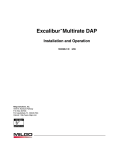

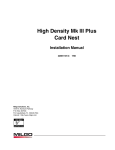
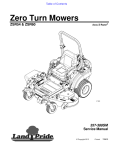
![T] .1](http://vs1.manualzilla.com/store/data/005831826_1-5c5b79be6c7f2f902c022f1ff12b7474-150x150.png)
